An obituary for Joe Gill in his hometown newspaper. Apparently, I now run "an obituary Web site featuring famous names in the comics industry." Sometimes, it sure feels that way.
Search Results for: Joe Gill
Joe Gill, R.I.P.
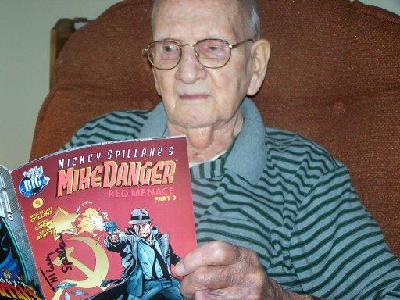
For several days now, the rumor has spread through comic book forums on the 'net that Joe Gill, one of the most prolific writers in the history of the medium, passed away last December. I've received many an e-mail asking me if it was true and why I hadn't posted something about it. Easy answer: I didn't know if it was true…and the people I knew who knew Joe Gill didn't seem to know if it was true, either. Mr. Gill had little or no family so there didn't seem to be a simple way to check and find out. Finally, sadly, I think I have sufficient confirmation.
Gill was born in 1919. His earliest known work in comics was for Timely (now Marvel) in the early forties and he was among the many writers who wrote Captain America after the departure of Simon and Kirby. In the late forties when the company switched over to teen comics and westerns, he was one of their busiest writers but he eventually fell into disfavor with the editor there, Stan Lee, and work began to become sporadic. By the early fifties, he was doing most of his writing for a company called Funnies, Inc., which supplied publishers with stories and artwork.
One of those publishers was John Santangelo of Charlton Comics. The comic book business was entering a rocky period with many companies going under and Santangelo decided he wanted to build a stable of writers and artists who'd work primarily in the firm's plant in Derby, Connecticut. For many, this meant relocating to that area but the deal included a certain stability along with very low rates. Someone once described the terms as "We'll pay you a third of what the other houses pay but we'll give you three times as much work." Santangelo was familiar with Gill's work (and legendary speed) via Funnies, Inc., and offered Joe a contract. Joe accepted and for the next three decades — until Charlton shut its doors — he was their star scripter, producing thousands of scripts for every kind of comic they published. In a business where some writers were pressed to write a book a week, Gill often produced a finished manuscript in a day.
His work included westerns (Billy the Kid, Wild Bill Hickok), war comics (Marine War Heroes, Fightin' Army), romance comics (Love Diary, Teen Confessions), crime comics (Crime and Justice, Vengeance Squad), science-fiction comics (Space Adventures, Doomsday Plus 1), comics based on movies (Konga, 1776), comics based on books (Jungle Tales of Tarzan), comics based on newspaper strips (The Phantom, Popeye), comics based on cartoon shows (Yogi Bear, Quick Draw McGraw), comics based on live-action TV shows (The Bionic Woman, Emergency), comics about martial arts (Yang, House of Yang), ghost comics (Ghostly Tales, Haunted), comics about car racing (Hot Rod Racers, Grand Prix), comics about surfing (Surf Kings) and anything else Charlton put out. He handled (and in some cases, co-created) a number of recurring characters and super-heroes, including Captain Atom, The Blue Beetle, Hercules, Peacemaker, The Fightin' Five, Sarge Steel, Son of Vulcan and Judomaster. In addition to all this, he worked often as a writer and/or editor on Charlton's many non-comic magazines, many of which featured pulp-style romance or crime fiction.
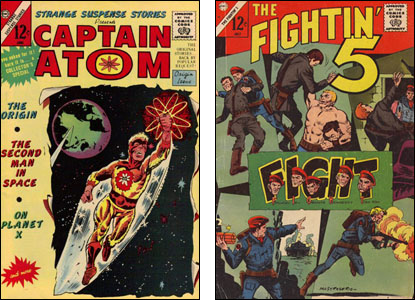
Charlton kept Gill so busy that he rarely had time to work for other publishers. He scripted a number of books for Dell in the sixties…for not much better money than he was receiving from Charlton. In 1968 when former Charlton editor Dick Giordano began working at DC, he brought Gill along and gave him work — at DC rates, which seemed astronomical to Joe at the time — on The Secret Six, Hot Wheels and a few other titles…but Gill's association with DC did not survive Giordano's ouster and it was back to the lousy money in Connecticut. He professed not to mind very much. Charlton's editors accepted whatever he did and rarely, if ever, asked for revisions. After the company shut down in 1986, Gill largely retired. In the company's waning days, he sold a few more scripts to DC for their ghost comics but when Charlton ceased publishing, Joe largely retired…and I'm afraid that's all I know about his later period.
There are a number of debates in the comic book community as to who stands as the most prolific writer in the history of the medium. The Guinness Book of World Records has recognized the late Paul S. Newman for that distinction…and he may well be, although he got in there in part because he was smart enough to submit himself as such. Others have argued for Stan Lee, Robert Kanigher or my personal nominee, Vic Lockman — but if anyone could ever properly calculate the numbers, it sure wouldn't surprise me if the winner turned out to be Joe Gill.
Joe Sinnott, R.I.P.
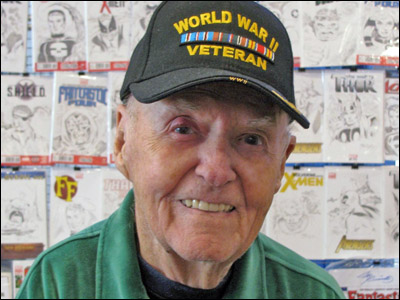
If you were in a crowd of folks who worked in the comic book industry and announced, "Joe Sinnott was the best inker who ever worked in comics," you wouldn't get a lot of argument. If you said, "Joe Sinnott was the nicest guy who ever worked in comics," you'd get even less.
He was not only a great inker, he was the guy who elevated that craft to an art; the guy who taught everyone else how it should be done. Almost every one of his peers studied what he did. Almost every one of his peers was told by some editor, at one time or another, "Try to do it more like Sinnott."
I met Joe via correspondence before I met him in person at the 1970 New York Comic Con. He couldn't have been nicer. A little later, I was sitting with Wally Wood, another fine artist whose work was much-admired and studied. Joe walked by and Wally asked me who that was. I told him it was Joe Sinnott. Wood, who'd done a lot of inking of Jack Kirby's art in his day, said, "That's the guy who inked Jack the way Jack should be inked. If I ever get another chance to, I want to do it like he does."
Joe was such a good inker, you forgot how good he was as an artist, doing it all himself. His photo-realistic style shouldn't have blended so well with such a wide range of pencil artists but it did. He always understood what they were trying to achieve on the page and what he should do to try and help them get there.
Joe Sinnott was born October 16, 1926 in Saugerties, New York, a city that would be his "home town" for his entire life. He grew up in a boarding house that catered primarily to teachers, several of whom saw talent in the young man's attempts to draw and encouraged him in that direction. He studied art in high school and also while in the Navy where he served in Okinawa during World War II. When he was discharged in 1946, he worked in a rock quarry for a few years before deciding it was time to resurrect his ambitions towards drawing.
Thanks to the G.I. Bill, he was able to attend the Cartoonists and Illustrators School (later known as the School of Visual Arts) in New York, where his work caught the eye of the school's co-founder, Burne Hogarth, and one of its main instructors, Tom Gill. Gill was drawing westerns and movie adaptations for Dell Comics and Sinnott spent nine months assisting him before deciding he was ready to solo.
His first job on his own was for St. John Comics but he soon broke in at Atlas (now Marvel) drawing war, western and horror comics for editor Stan Lee. Lee liked Sinnott's crisp style and the fact that the work was always well-researched and in on time. Joe later worked for other publishers including Treasure Chest, Charlton and Archie, but his main work was for Marvel, especially after Stan discovered how well Joe could ink the work of other artists.
Joe really got noticed as an inker for the pencil art of Jack Kirby. He inked several early, pre-superhero stories by Kirby and when the "Marvel Age" began, handled several key tales, including the first Thor story in Journey Into Mystery and the debut of Dr. Doom in Fantastic Four #5. Joe also drew the Thor strip for a time. Stan wanted Joe to ink as much as possible for Marvel but at the time, the company's low rates forced Joe to turn him down. Finally though, the pay was raised and Joe abandoned his Archie inking to work full-time for Marvel.

Some would call him Kirby's best inker. Even though he didn't meet Jack until years after their major collaborations, he understood the way Kirby drew and knew how to separate the planes of a drawing and make Kirby's special brand of forced perspective work to maximum effect.
Joe inked almost every major Marvel artist at one time or another and kept Fantastic Four consistent through a succession of different pencilers after Kirby. At times, he made their best artists like John Buscema and Gene Colan look great. Editors also knew that Sinnott could raise the quality of weak penciling (or finish sparsely-penciled art) and assigned him to those jobs.
No matter what they threw his way, Joe made it look good and always got it in on time. Always. No editor ever had a problem with Joe Sinnott. No editor didn't wish he had a lot more Joe Sinnotts at his disposal.

I've met darn near every major writer and artist who worked in comics from the sixties through the eighties. I never met a nicer man than Joe Sinnott, and few who were as inarguably good at what they did. Joe was a gentleman in every sense of the word. I could cite dozens of examples but this one will do…
In 1975 at a comic convention in New York, we made plans to meet for lunch. Just before we were about to leave the con and head across the street, a fan asked Joe for an autograph. Then another asked and another. The requests escalated into quick sketches and soon, Joe was mobbed by folks who loved his work and simply had to have a little Thor or Thing drawing from the great Joe Sinnott. After several dozen of these had delayed our lunch departure by close to an hour, I waded into the throng to play Bad Guy, stop the sketching and drag Joe off to eat.
He declined. He didn't want to disappoint all the people who were swarming around him, some of whom had been waiting for that entire hour. At his behest, my friends and I went to lunch without him. I brought him back a burger and found him in the same place, still sketching for fans. Three hours later, he was still at it and the hamburger was stone cold and untouched. If the convention hadn't kicked everyone out and closed that room, he'd probably still be there.
That was the Joe Sinnott I knew. Like I said, I never knew anyone nicer. I miss all these great artists who are, way too often, the subject of obits on this page but I'm really going to miss Joe. He died peacefully this morning at 8:40am at the age of 93, beloved by all who knew the man and his work.
Happy Retirement, Joe Sinnott!
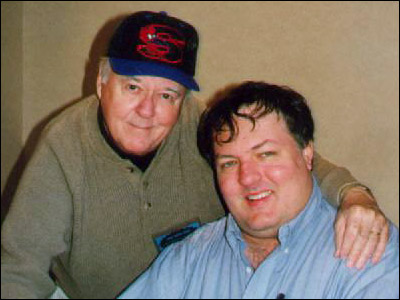
That's Joe Sinnott in an old photo. (The other guy is me in hairier days.) The Spider-Man newspaper strip just ended and that was the last thing Joe was working on so the 92-year-old artist is officially retired.
He actually retired from full-time work for Marvel in 1992 but put in an extra 27 years inking the Spider-Man feature. That caps a 69 year career in comic books. I will retype that sentence so you can read it again: That caps a 69 year career in comic books. That would be impressive even if the work was mediocre and the artist was often late turning it in. As it happens, Joe was never late and the work was never anything but excellent.
Joe Sinnott started in comics in 1950. At first, he was mostly an assistant helping out other artists, mainly Tom Gill. Within two years though, he was drawing whole stories on his own as well, though he occasionally teamed with others. His work was clean, precise and when necessary, meticulously researched. In the sixties though, he turned more often to inking the pencil art of other artists, most famously on Jack Kirby's work for Fantastic Four. He would eventually ink almost every major Marvel artist and work on almost every major Marvel title.
In so doing, he redefined what it meant to be an inker in comic books, setting a new standard and causing new artists — and even many of his contemporaries — to study and ape his work. He made poor artists look good and good artists look spectacular. I don't like superlatives like "Joe Sinnott was the best inker in comics" but if you said that in a hall filled with professional artists, you wouldn't hear much disagreement. You might not even hear any.
So he was brilliant at what he did and he always met deadlines. Is there anything else I can say about the man? Oh, yes: He was and still is one of the nicest people to ever work in the industry. Such a gentleman. Congratulations, Joe, on one of the great careers ever in comics. Now, take it easy and please show up at more conventions so we can all tell you how much we love you and all that wonderful artwork you gave us.
Tom Gill, R.I.P.

Veteran comic book and strip artist Tom Gill has died of heart failure at the age of 92. Gill was born in Brooklyn and his career as a professional artist began with a staff job at the New York Daily News. He was never certain what year but he was there in time to draw a map of Pearl Harbor that ran in the paper the day of the infamous bombing. He later worked for the New York Times and the New York Herald Tribune and for the latter, he drew a short-lived strip about a cab driver named Flower Potts. Around 1948, he began drawing for comic books and notched a 20+ year run on the Lone Ranger comics for Western Publishing (Dell, Gold Key). He did dozens of other comics for Western, specializing in westerns and — as he put it — "anything with a horse in it." His Fury comics, based on the TV series about a stallion, were especially striking and other artists used them as reference for horse-drawing. Gill also drew comics for Harvey, Toby Press, Marvel and other companies, and illustrated a fair amount of childrens' books for Western. When the Man From U.N.C.L.E. TV show was big, Gill illustrated dozens of books and activity books based on the series.
Of all his many accomplishments, Tom was proudest of his 50+ year stint as an instructor at the School of Visual Arts in New York. There, he taught over 2,500 students, many of whom went on to become prominent in the field of comics, advertising design and animation. A few of them assisted him on his comic book work before graduating to their own assignments, including Joe Sinnott, Herb Trimpe and John Verpoorten. He was also justifiably proud of his work with the National Cartoonists Society, serving several terms as its vice-president. The N.C.S. awarded him its coveted Silver T-Square award in 1964 and its award as Best Comic Book Artist in 1970. (He was then primarily doing the Bonanza comic book for Gold Key. A few years earlier, he drew a few issues for the company of The Owl, a new super-hero creation of Jerry Siegel.)
I met Tom at a New York convention about ten years ago. Veteran artist Dick Ayers, who sometimes worked with him, introduced us by telling me, "You're about to meet one of the real giants of our business." He was right, but Tom sure didn't conduct himself like he thought he was a giant. He was funny and charming and genuinely pleased that I knew who he was…and when I told him how much I admired the work of some of his students, like Joe Sinnott, he beamed with pride. Last year, we had him as a Guest of Honor at the Comic-Con International and I got to spend time with him and interview him. He had a true love of art and cartooning and talent…and it showed.
Here's a link to the Reuters obit and here's a link to a recent article about Tom. He was just what Dick Ayers said he was.
A Charlton Mystery
Warning: The following story is a mystery with no verifiable ending…just speculation. If you're the kind of person who likes your questions to have solid, inarguable answers, you might want to find something else on the Internet to read instead of the following…
Charlton Press was a comic book company that existed roughly from 1945 to 1986. They published a lot of comic books and back when I was a kid, I kind of rooted for them the way you might root for any underdog. They didn't have a lot of memorable characters and their books were cheaply printed and the stories were often kind of sappy. Real good artwork did appear in them but not often. As I later learned, the company had a reputation for paying its writers and artists poorly and…well, it showed.
Sometimes though they got more than they paid for. A guy named Joe Gill wrote an awful lot of them and he'd just bang out story after story after story, whether he had an idea for one or not. Occasionally, he hit a vein of gold. Sometimes, Steve Ditko drew for them as did a couple other good artists like Dick Giordano and Rocke Mastroserio. I started buying Charltons when I was about ten and with few-and-far-between exceptions, I liked them then more than I did when I got older.

Most of those I bought, I bought at second-hand book stores, most of which charged a nickel each or you could get six comics for a quarter. Needless to say, I only bought comics at such stores in multiples of six. That was how I started buying comics from different companies. For a while, I was only buying DCs but one day at some store, I found some quantity of DCs I wanted like 23 or 35…where one more comic would be free. So I'd take some interesting-looking Marvel home as my free comic and I'd like it so much that I'd find myself collecting DCs and Marvels…
…and then one day at some store, the pile of DCs and Marvels I wanted would be, say, 47 and since one more comic was free, I'd try a comic from some other company. I'm pretty sure that's how I started buying Charltons.
Used book shops were a good place to buy Charltons, not just because they were cheaper but because those stores were a good place to find them. Many of the stores I frequented here in Los Angeles to buy new comics simply didn't carry them. The few that had any Charlton comics didn't have many. Even later when I began to learn some things about comic book distribution back then, I couldn't understand why Charlton's product wasn't as available as comics from DC, Marvel, Archie, Harvey, Dell, Gold Key or one or two others.
I still don't know why but that's not the mystery that this post is about. The mystery that this post is about occurred one day at a used bookseller on Santa Monica Boulevard near Sawtelle. I'd picked out some comics to purchase when the guy who ran the place asked me if I collected Charlton Comics. I said I did and he took me into the back room and showed me five boxes of comics he'd recently acquired. Let me describe what was in them…
Each box had about a hundred Charlton Comics. Every single comic was in perfect condition as if they'd just come from the printer and never been read. And what they represented was one copy of every single comic that Charlton had published in about the last two years.
There were copies of Army Attack, Army War Heroes, Battlefield Action, Billy the Kid, Black Fury, Blue Beetle, Brides in Love, Cheyenne Kid, Fightin' Army, Fightin' Five, Fightin' Marines, Fightin' Navy, First Kiss, Freddy, Frontier Scout Daniel Boone, Gorgo, Gunmaster, Hot Rod Racers, I Love You, Jungle Tales of Tarzan, Just Married, Konga, Li'l Genius, Love Diary, Marine War Heroes, Marines Attack, Montana Kid, My Little Margie, Mysteries of Unexplored Worlds, Navy War Heroes, Outlaws of the West, Romantic Story, Sarge Steel, Secrets of Young Brides, Six Gun Heroes, Strange Suspense Stories, Submarine Attack, Sweethearts, Teen Confessions, Teenage Hotrodders, Teenage Love, Texas Rangers in Action, U.S. Air Force, Unusual Tales, War Heroes, Wyatt Earp and maybe a dozen others.
The storekeeper told me someone had brought them in and swapped them for two cents per comic in store credit, not cash, and had picked out ten bucks worth of old books (not comics). He would let me have the lot of them for twenty dollars. I offered fifteen. He said, "It's a deal if you get them out of here today."
I was about thirteen years old when this happened. I didn't have a lot of money but I had enough for this transaction. During all this, my father had been patiently waiting in his car outside, reading the newspaper. When I think about how good comic books have been to my life, I am grateful for my father's willingness in those years to drive me to second-hand bookstores and sit outside in his car reading the newspaper while I went in.
He was a little startled when I came out carrying crates of comics but by that age, he was used to his son surprising him…and he figured I knew what I was doing even though I didn't always figure that. I had to make five trips to his car.
The comics were not in order and it wasn't until I got them home and did some sorting that I realized what I'd acquired. It was, as I said, one of every comic book Charlton had issued for two years. That wasn't readily apparent to me until I realized that Six Gun Heroes had changed its title to Gunmaster and continued the numbering. Or that Charlton published five issues of Blue Beetle numbered #1-5, then they stopped Unusual Tales after #49 and followed it with Blue Beetle #50. So the numbering of Blue Beetle went #1, #2, #3, #4, #5, #50, #51 and so on…
Charlton did things like that all the time and back then, there were no reference books in which I could look this stuff up. I had to figure it out for myself.

But that also is not the Charlton Mystery that this post is about. The mystery is: "Where the heck did this collection come from?"
How or why could or would anyone collect one copy of every Charlton comic for two years straight? They didn't miss one issue, even with Charlton's rotten distribution and its comics changing names as effortlessly as some people change socks. I could understand (maybe) being a lover of Charlton's romance comics or their war comics or every comic they put out with the words "Fightin' or "Attack" in its title…but every Charlton comic? And in perfect condition? How? Why?
Here's the best theory I came up with and if you have a better one, I'd love to hear it…
Someone in Los Angeles had a relative who worked for Charlton…or some business connection. Maybe some artist or writer who worked for the firm lived out here. Charlton for some reason sent them, individually or collectively, one copy of every comic that came off their presses and the recipient just tossed them all in boxes. That would explain the perfect condition. One day, they looked at the accumulation and said, "I'm sick of having this stuff piling up like this. I'm going to take them to a used book shop and I'll take anything they'll give me for them."
That's all I've got. I don't even have all those comics. I traded or sold 'em off long ago but I still sometimes wonder where they came from.
This Year's Bill Finger Awards

The fine folks who run Comic-Con International today announced…
Six Posthumous Recipients to Receive 2020 Bill Finger Award
Six writers who contributed mightily to the history of comics have been selected to receive the 2020 Bill Finger Award for Excellence in Comic Book Writing. The selection, made by a blue-ribbon committee chaired by writer-historian Mark Evanier, was unanimous.
"In a year where Comic-Con cannot take place, it seemed wrong to honor, as we usually do, one posthumous writer and one who is still with us," Evanier explained. "The one who is still with us would be denied the full honors of being brought to the convention and presented with the award onstage. Therefore, after much discussion, we decided to instead present no ‘alive' award this year, and, assuming there is a convention in 2021, we will present two of those awards then. For 2020, we have selected six writers from the dozens who have been nominated to receive the posthumous award. Each of these six during their time in the industry produced a body of work that the judges deem worthy of more recognition and/or reward than it has received."
The Bill Finger Award was created in 2005 at the suggestion of the late Jerry Robinson, who worked with Finger, knew him, and was disturbed that Bill had received so little credit and compensation for his work in comics, especially with regard to Batman and that character's supporting cast and world. As Evanier explains, "Though Bill Finger now receives a lot more recognition than he received in his lifetime, there are still many who do not, and that's why we keep giving out these awards." This year's recipients are, in alphabetical order:
Virginia Hubbell Bloch (1914-2006)
The writing of Virginia Hubbell Bloch — almost wholly uncredited, some signed by others — could be found for years in the pages of Lev Gleason Publications, MLJ Comics, and Dell Comics in the forties and fifties. A poet and copywriter before she met her first husband, comic book artist Cari Hubbell, she began writing scripts, some drawn by her husband and some not, in 1941 for MLJ, which would later be known as the Archie company. That was where she met editor-writer Charles Biro, who encouraged her to write comics and who went on to become the most famous comic book writer of his day, often credited on covers. Artists who worked for him at Lev Gleason later told historians that many of the scripts credited to Biro were clearly ghostwritten by Virginia Hubbell, especially for the popular Boy Comics and the Lev Gleason version of Daredevil. On her own, she also wrote for Marvel, St. John, and Western Publishing, where she mainly wrote Little Lulu. She also wrote plays and children's books, credited (when she was credited) as Virginia Bloch after she divorced Carl and remarried.
Nicola Cuti (1944-2020)
Nick Cuti began his writing (and drawing) career in 1968 with the self-published underground comic book Moonchild, much of which was done while he was serving in the Air Force. After his service, the popularity of Moonchild led to a series of jobs, including working for animator Ralph Bakshi, assisting artist Wally Wood, and serving as an assistant editor and writer at Charlton. Charlton led to Warren Publishing, and Warren led to DC. Along the way, he co-created E-Man and a spinoff comic, Michael Mauser, with artist Joe Staton. Cuti's writing for those comics won great critical acclaim, especially in bringing a fresh approach and a healthy sense of humor to a superhero title like E-Man. He later worked extensively as an artist in animation, as a writer-producer of short independent films, and an author of both text and graphic novels, some of which revived his beloved Moonchild. Nick left us earlier this year, and we look forward to a representative of his family joining us at the 2021 ceremony for a more formal recognition of his work.
Leo Dorfman (1914-1974)
Leo Dorfman began his comic book writing career in 1950, following years of writing mystery and romance novels under a wide array of pseudonyms. Utterly uncredited for most of his first two decades in comics, he first worked for Fawcett Comics until they cut back in production and sent all their freelancers scurrying for other markets. It wasn't until 1957 that he connected with Western Publishing, writing westerns based on TV shows such as Cheyenne and Gunsmoke at first, later segueing to The Twilight Zone, Boris Karloff's Tales of Mystery, Ripley's Believe it or Not, and other comics filled with ghost stories. In 1960, he began writing for Mort Weisinger at DC, contributing to the world of Superman with tales not only about the Man of Steel but also Jimmy Olsen, Lois Lane, Superboy, and Supergirl. Among his many contributions to the mythos was that in Superboy, he introduced the character of Pete Ross. He also penned "The Amazing Story of Superman-Red and Superman-Blue!", which ran in a 1963 issue and was considered one of the most memorable stories to ever grace the Superman comic book. At the same time, he wrote hundreds of stories for Western under the Dell and Gold Key imprints and hundreds more for DC. In 1971, he launched the comic Ghosts for DC, filling it with allegedly true tales of the unexplainable and quickly becoming the top seller of all the DC titles that offered such stories in anthology format.
Gaylord DuBois (1899-1993)
Gaylord DuBois spent over 30 years writing comic books and children's books for Western Publishing, the comics appearing under the Dell and Gold Key imprints. His work for them included thousands of scripts for well-known properties including The Lone Ranger, Red Ryder, Bat Masterson, National Velvet, Sergeant Preston of the Yukon, and Roy Rogers, as well as stories featuring his own co-creations, The Jungle Twins, Brothers of the Spear, and Turok, Son of Stone. Between 1947 and 1971, he wrote an estimated 95 percent of all the comics Western produced of Edgar Rice Burroughs' Tarzan of the Apes. During his run on it, the Tarzan comic book was consistently one of the top-selling comics in America; in the sixties, so was a comic DuBois wrote every issue of except the first: Space Family Robinson. During this time, he also wrote novels, Big Little Books, and other text-based publications for Western, many of them featuring the same characters. In his last years, DuBois — a devout Christian who occasionally taught Sunday school or filled in for a pastor on vacation — authored several Christian-focused comic books and books of inspirational poetry.
Joe Gill (1919-2006)
Suggested by some as the most prolific comic book writer of all time, Joe Gill began his career in the mid-1940s, working for his brother Ray Gill at Funnies, Inc., a company that created content for many comic book publishers. Soon, Joe was working directly for most of those publishers, including a staff job at Timely (now Marvel), where he wrote The Human Torch, Captain America, and, from all reports, every kind of comic they published. Around 1948 when Timely laid off a number of staffers, Gill connected with Charlton Comics, where he wrote a minimum of one comic a week until the firm ceased publishing in 1986. Some who worked with him claimed it was more like one comic per day, which was what it took to make a decent living working for a company that paid such low rates. Few Charlton titles during those years did not feature some Joe Gill scripts, but the best remembered books would include Konga, Gorgo, Billy the Kid, Cheyenne Kid, Ghostly Tales, The Many Ghosts of Dr. Graves, The Phantom, Flash Gordon, Popeye, Tales of the Mysterious Traveler, and all the other western, war, romance, and ghostly titles. He was the co-creator of Captain Atom, Peacemaker, The Fightin' Five, and Sarge Steel, among others. He also worked briefly for DC, Dell, and a few other publishers, but just his astounding output for Charlton earns him a Finger Award.
France Edward Herron (1917-1966)
France "Eddie" Herron was referred to as "the first comic book writer" by some of his contemporaries. The honor is arguable, but he was writing and editing as early as 1937, mainly for the Harry "A" Chesler studio, which produced comic book material for several publishers. He worked for Centaur Comics, then for Victor Fox's outfit, which is where he met and began a long association with Joe Simon and Jack Kirby. Among the other companies he worked for, often simultaneously, were Timely (where he worked with Joe and Jack on Captain America and co-created The Red Skull), Quality Comics, and Fawcett (where he wrote many early stories of the original Captain Marvel and co-created Captain Marvel Jr.). In 1945, he began a long association with DC Comics, where he often wrote Superman and Batman stories, and he was the main writer for long stints on Boy Commandos, Green Arrow, Challengers of the Unknown, and Tomahawk. His scripts appeared in all their war, western, romance, crime, and mystery titles, and he co-created the character, Cave Carson. Among the many newspaper strips he authored were Bat Masterson, Davy Crockett, Rip Tide, and Captain Midnight.
The Bill Finger Award honors the memory of William Finger (1914-1974), who was the first and, some say, most important writer of Batman. Many have called him the "unsung hero" of the character and have hailed his work not only on that iconic figure but on dozens of others, primarily for DC Comics.
In addition to Evanier, the Finger Award selection committee consists of Charles Kochman (executive editor at Harry N. Abrams, book publisher), comic book writer Kurt Busiek, artist/historian Jim Amash, cartoonist Scott Shaw!, and writer/editor Marv Wolfman.
The Finger Award falls under the auspices of Comic-Con International: San Diego and is administered by Jackie Estrada.
ASK me: Comics on Broadway
Micki St. James has today's question…
Just occurred to me so I thought I'd ask — has there ever been a good comic based on a Broadway show? There have been great comics based on movies of course (Sword in the Stone) and TV shows (Zorro) but I don't remember any My Fair Lady or Damn Yankees comic book.
I can think of Broadway shows based on comic books but no comic books based on Broadway shows unless you count these two…
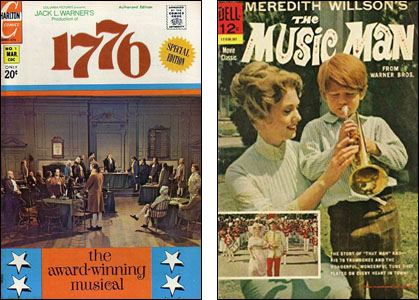
In 1973, Charlton put out a comic book based on the movie of the Broadway show 1776. I wrote about it here. It was adapted by writer Joe Gill and drawn by Tony Tallarico.
Before that — in 1963 — Dell put out an adaptation of the movie based on the Broadway show The Music Man. As with the adaptation of 1776, it's rather odd to see the story told without the songs and it doesn't fare well. I don't know how anyone could fall in love with Professor Harold Hill if you didn't see him sing and dance…and what's The Music Man without a rousing performance of "The Shipoopi?"
Just who wrote the comic is unknown and for a long time, the identity of the artist was a maddening blank to those of us who obsess over such mysteries. Then a year or three ago, comic book scholar Martin O'Hearn figured it out and we all sighed, "Of course!" The rest of us can perhaps be forgiven because John Forte usually inked his own pencil art and here, someone else did the honors. We aren't sure who that "someone else" is.
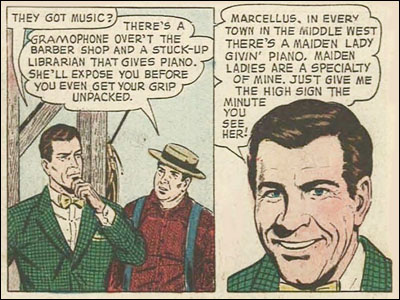
John Forte (pronounced "fort") was a prolific comic book artist who "broke in" around 1945 working for, as so many beginners did then, the Iger shop. By 1950, he was working for almost every publisher in town but mainly for Quality Comics — on Blackhawk, among other features. When Quality shut down, he worked primarily for Atlas (aka Marvel) on just about all their non-funny funnybooks and then mainly for ACG. ACG was kind of a "farm team" for DC Comics and while working for them, he began getting jobs from DC, working for them until his death in 1966. He was then primarily drawing Jimmy Olsen for DC and when he passed, he was replaced by another ACG mainstay, Pete Costanza.
At DC, he inked a lot of stories penciled by Curt Swan and did well-remembered stints as penciler-inker of two features in particular. He was the artist on "Tales of the Bizarro World" in Adventure Comics and some have suggested he was the ideal artist to draw an imperfect version of Superman because he was an imperfect version of Curt Swan. When the Bizarros left Adventure Comics, their spot in the book was taken up by "Tales of the Legion of Super-Heroes" drawn by…John Forte. It was the first regular feature of The Legion and Mr. Forte designed a lot of the characters who formed that team. Reportedly, he struggled to draw those stories every month with their crowded panels but still somehow found time to draw the Music Man comic and a couple of others for Dell.
Someone else may come up with a comic book based on a Broadway show but…oh, wait! In 1971, there was a science-fiction play called Warp! from the Organic Theatre Company of Chicago. It was actually a trilogy and it ran there for a year before a brief, unsuccessful move to Broadway in 1973, closing after seven previews and eight performances. Ten years later, First Comics — which was based in Evanston, Illinois near Chicago — published a Warp! comic book based on the play. Does that count? Maybe someone else will come up with one that doesn't occur to me right now.
Vic Lockman, R.I.P.
I am informed that cartoonist and comic book writer Vic Lockman died last June 1 at the age of 90. This may be the first obit published on the 'net of the man who just might have been the most prolific comic book writer of all time and the least well-known. A great many folks who consider themselves expert comic book historians who will read this and say, "Who the heck was that?" I'm afraid I can't tell you much about the man other than what little follows.
He wrote thousands of comic book stories for Western Publishing Company beginning around 1950. These were for their Dell and Gold Key comics. For an explanation of the relationship between Dell Comics and Western Publishing, click here.
Mr. Lockman was also an artist who occasionally penciled what he wrote, usually puzzle pages or one-page gags. More often, he would letter and/or ink a story that someone else had penciled. Most often, he just wrote.
For which comics did he write? Lockman stories ran among scripts by others in all the Disney comics, all the Warner Brothers comics, all the Walter Lantz comics, all the Hanna-Barbera comics and any other "funny" comics produced out of Western's Los Angeles office. He was the main guy behind a seventies comic called The Wacky Adventures of Cracky and he has been credited with creating the Disney character, Moby Duck. For years, a division of the Walt Disney company in Burbank was also producing comic book material for European publishers who needed more pages than they got by translating all the Gold Key books. Lockman also did hundreds of scripts for them.
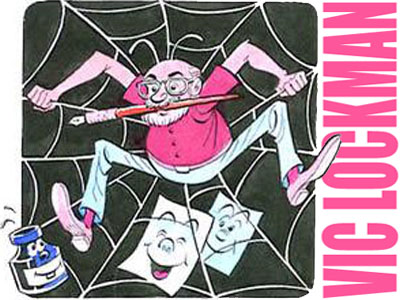
After Western shut down its comic book division in 1984, he wrote a few scripts for later American publishers of Disney comics but he seems to have redirected most of his efforts to his other endeavor — comics for the Christian marketplace. More on them in a moment. First, let's discuss how many stories Lockman might have done for non-religious comics…
I can't give you a precise total but I'm sure it was a staggering number. In a self-promotional piece Mr. Lockman issued in the mid-seventies, he claimed he wrote one script a day, Monday through Friday, for a total at that point of around 7000. We don't have a clear idea of what time period he was basing that on but if you figure five scripts a week and 52 weeks per year, that's 260 scripts annually. As noted, he started around 1950 so if he'd adhered to that schedule, he would have written 7000 scripts by 1977 — and he was actively producing scripts for Western and the Disney foreign comics program in 1977. At that rate, he might have hit 8000 by the time he stopped writing.
I'm skeptical anyone could keep up that pace but it's not impossible. He was probably counting the Christian comics and also scripts that his editors at Western and Disney didn't accept. When I was writing for Western, they rejected about 15% of what I wrote and my editor there, Chase Craig, used to tell me, "Don't feel bad. You should see how many of Vic Lockman's scripts I turn down." Lockman might have sold some of his rejected Disney scripts for Western to the Disney foreign comic program (or his rejects from them to Chase) but some of them probably went unpublished. And since he had no other place to sell his rejected non-Disney scripts for Western, they were presumably never published. Those all would be impossible to count.
Further complicating that count is that in the fifties and sixties, so much of what Lockman did for Western was one-page puzzle and gag features. He did hundreds upon hundreds of them. Was he counting each of those as a "story?" Probably.
That's important to consider if we weigh his output against that of Paul S. Newman, who was recognized by The Guinness Book of World Records as the most prolific comic book writer of all time. They credit Paul with more than 4,100 published stories totaling approximately 36,000 pages. If each of Lockman's one-pagers is to be considered a story than he might have topped Newman in total stories but lost to him in total page count. It's kind of an Electoral College situation.
Newman was able to present sufficient documentation to get the Guinness people to accept his claim. I doubt that kind of proof could be assembled for Vic Lockman — or for that matter, for two other contenders for the title: Charlton Comics writer Joe Gill or Archie writer Frank Doyle. I would not doubt for a second though that Lockman was one of the five most prolific comic book writers of all time, probably one of the three most prolific…and possibly Numero Uno.

And I could not begin to estimate his productivity for the Christian marketplace. His vast catalogue of books, many of which he published himself, included titles such as Biblical Economics in Comics, a multi-volume series called Catechism For Young Children With Cartoons, God's Law for Modern Man, How Shall We Worship God?, Psalm Singing for Kids, The Big Book of Cartooning (In Christian Perspective) and hundreds of self-published tracts. I have — shall we say? — problems with some of his lessons but it's obvious Mr. Lockman was a very sincere and talented cartoonist.
He sold many of these through his website and you can still see them there, though I have no idea if anyone is still filling orders. In some of them, he argues, a la Judge Roy Moore, that his interpretation of God's word is the only true one and that it outranks any law made by Man. In my brief contacts with Mr. Lockman — two phone calls almost 30 years apart, nothing in person — he was cordial to me until he began to proselytize and I declined to convert on the spot.
The second of these conversations was a few years ago when I called to sound him out as a potential recipient of the Bill Finger Award for Excellence in Comic Book Writing, which I administer and which goes to writers who have not received sufficient recognition and/or reward. Since Lockman certainly qualifies for lack of recognition, I wanted to see if he'd consider accepting it should the judging committee select him some year. I am not sure I completely understood his response but it was unmistakably negative about the award and the whole concept of celebrating comic books that do not celebrate God's covenants.
Each year, the Finger Award goes to one recipient who is alive and to one posthumously. I decided not to propose Mr. Lockman for the "alive" one until such time as a few nominators did. Since we started the award, we've received over a thousand nominations for around 250 different writers. We have received one or less for Vic Lockman…which kind of proves he has not received the attention he deserves. Maybe we can do something about that with the posthumous award one of these years. A career like he had is absolutely deserving of attention.
Sam Glanzman, R.I.P.
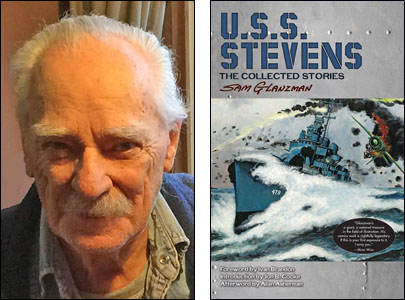
Sam Glanzman, whose career in comics spanned more than 75 years, died early this morning at the age of 92. He had been in hospice care since he took a bad fall and his friend Drew Ford was running a GoFundMe campaign to raise money to cover medical bills for Sam and for Mrs. Glanzman. I'll direct you to that page after I tell you a little more about Sam.
Glanzman got into comics in 1939, joining his brothers David and Louis who were also artists in the formative years of the industry. Like his brothers, he worked at first for Funnies, Inc., an agency that commissioned comic book stories and art and then sold that material to publishers. Sam's early artwork and some writing he did seem to have appeared first in the pages of comics published by a short-lived firm called Centaur. His drawing can be seen in Amazing-Man Comics, Amazing Man having been created by Bill Everett who would soon be better known for The Sub-Mariner. Glanzman worked for other publishers (especially Harvey) but his career was interrupted by World War II.
He served in the Navy, mainly aboard the destroyer U.S.S. Stevens, before being discharged in 1946. Upon his return to civilian life, he decided there was better money to be made in other fields and pursued them. He worked in aviation yards, lumber mills and other jobs that required manual labor but occasionally detoured in and out of comics, either on his own or assisting his brother Louis, who went by the name, Lew Glanzman. Around 1958, Sam dove back into comics full-time, working for two of the lowest-paying companies around — Charlton and then Dell.
His most notable series for Charlton was probably Jungle Tales of Tarzan, a series unauthorized by the Edgar Rice Burroughs estate which put a quick end to it. Two other well-remembered series were "The Lonely War of Willie Schultz," a well-written (by Willy Franz) series that ran in Fightin' Army. Its human insights stood out among the hundreds of war comics before and after. He also with writer Joe Gill gave us Hercules: Adventures of the Man-God, which put a fresh, distinctive spin on a very old legend.
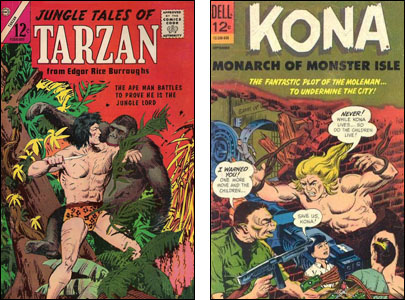
For Dell, he drew many comics but is best remembered for Kona, Monarch of Monster Isle, about a man struggling to survive on a lost island full of dinosaurs. It and other fine works of the sixties finally caught the attention of the better-paying companies and Glanzman began doing most of his work for DC on its war comics. He did long stints on "The Haunted Tank" and other features but his finest work was on a series of short, autobiographical stories he wrote and drew under the banner title, "The U.S.S. Stevens." He later did other stories of his World War II experiences including a superb 1987 graphic novel called A Sailor's Story. Much of this work has been reprinted for an appreciative audience.
I had the pleasure — and believe me, it was — of having Sam on a panel at the 1999 Comic-Con International where he also received its precious Inkpot Award. I saw him at other conventions and he was always glad to talk about his long career; that is, when he wasn't servicing a long line of people who wanted to get his autograph and to tell them how much they loved Kona or Hercules Jonah Hex or any of the other fine, testosterone-loaded comics he drew. He seemed very humble and even a bit amazed that he was able to make a living so long in comics.
As mentioned, Drew Ford is running a GoFundMe page to raise bucks to pay medical bills for the Glanzmans. Though Sam has left us, I'm sure many bills remain and you can show your appreciation for 75+ years of very hard work drawing piles of very good comics by going to that page and participating. And if you're not familiar with that work, see if you can't track down some of it. Here's a tip: Though Sam handed mythic legends like Tarzan and Hercules, his best comics were the ones about the most heroic figure he drew…Sam Glanzman.
Piddle, Twiddle
Two of my areas of interest — comic books and Broadway — came together in 1973 when Charlton Press issued one of the oddest comic books ever. In connection with the release of the motion picture version of 1776, they brought out an adaptation that was…uh, interesting. Western Publishing used to do this kind of thing for their Dell and Gold Key lines but by '73, they'd stop doing that kind of thing. Almost every comic book company had.
I have no inside info on how it came about but I have a pretty fair guess. My guess is that someone at Columbia Pictures remembered when they used to arrange that kind of merchandising with Western or Dell and approached them about it and were turned-down. I'd further guess they went to DC and Marvel and maybe other places before hooking up with Charlton, a firm which didn't say no to much. Charlton occasionally produced some fine comics but they paid poorly and had lousy printing and my sense is that almost every company that made a licensing deal with them was unhappy with the end-product.
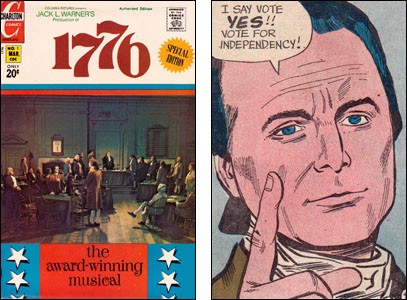
At about this time, Hanna-Barbera was doing a lot of comics with Charlton and when the contract ended, they yanked it away and set up a new operation which I worked for. One of the guys I worked for had largely gotten his job because the guy before him had been fired for many bad deals, one of which had been the license to Charlton. I would be surprised if whoever made the deal for the 1776 comic was any happier with how things turned out.
The comic was written by Joe Gill. The Guinness Book of World Records recognizes Paul S. Newman as the most prolific writer of comic books ever. I liked Paul and he sure wrote a lot of them but I always suspected he was in there because he got the bright idea to submit himself for the title. I can think of several other guys who might qualify, one of whom is Joe Gill. Charlton paid so poorly that in order to make a living, Gill had to churn out scripts around three times as rapidly as the guys working for DC or Marvel. Enough of it was good that you have to wonder what he could have done writing at a more human pace.
His adaptation of 1776 was not among his better efforts…nor could it have been, trying to cram a 141-minute movie into 31 pages of comics. (141 was the original release length. Some home video versions run longer.) The songs, of course, were absent but some of the lyrics were retooled as dialogue. Large chunks of the plot were eliminated…
…and, oh yes: Gill cut out all that stuff about slavery.
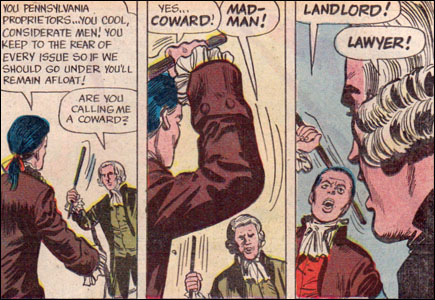
I assume he was ordered to do that and oddly enough, it may have been a good cut for reasons of space. I doubt he had the room to treat that topic with any sensitivity. (Or maybe Gill looked at his working arrangements with Charlton and just found the whole topic personally distasteful.) In his abridgement, the primary obstacle to getting the Declaration of Independence approved and signed was merely that various delegates were squabbling about various points, most of them largely unnamed. Most of the romantic tensions between John and Abigail Adams, as well as the romance of Mr. and Mrs. Thomas Jefferson, were also trimmed way down.
The artwork was done by Tony Tallarico, who did a lot of work over the years for the lower-paying companies. As with Gill, I suspect he had a lot of talent that didn't show through the low, low rates he was paid. He did a decent job drawing William Daniels in the lead role and seems to have not been given sufficient photo reference on anyone else. It had to have been one of his tougher assignments since all it was really was 31 pages of guys in colonial garb arguing with each other.
Charlton's costs were so low that they probably made a few bucks off the comic, especially if (as there may have been) some sort of promotional deal where copies were given away in some areas to promote the movie. That was done with many of the film adaptations that Western or Dell did.
Anyway, that's about all there is to say about this comic. I am by no means suggesting you seek out a copy of it because it's not good in a bad way or bad in a good way. Given the assignment of adapting a musical about slavery without the music or slavery, I doubt anyone could have done much better. It's just one of the oddest comics I ever came across. And you may have some idea of how many comic books I've seen in my day…
IAQ11
![]()
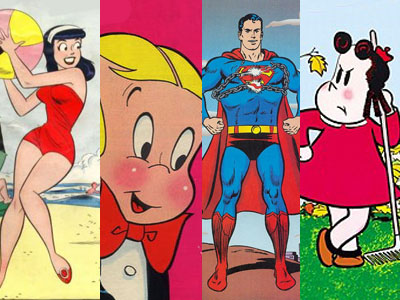
Which writer or artist has had the longest streak working on one comic book?
It depends how you score. Curt Swan did thousands of pages of Superman, Warren Kremer did thousands of pages of Richie Rich and Dan DeCarlo did thousands of pages of Archie…but those pages weren't always published in consecutive issues. Swan, for example, was moved around between Superman, Action Comics, Adventure Comics, Superboy and a few other books, and even when he was pretty steadily on one book, an issue by someone else would occasionally be dropped in between his.
This really had nothing to do with Curt's productivity. Every month, he drew 30-40 pages of whatever comics his editors had him draw. None of his associates would doubt that, had DC decided to make the Superman comic his priority assignment, he would have drawn every issue for around 40 years and never missed a month.
The same is true of many other artists, such as Dick Dillin. Dillin was the lead artist on Blackhawk for around 20 years, but short stories were occasionally dropped in by others because his editors wanted him to do other strips, as well. He only stopped doing Blackhawk because DC assigned him elsewhere and then cancelled the title. He would have done it for another 20+ years if they'd continued it and kept him there…but they decided he was needed on, among other books, Justice League of America. He drew J.L.A. #64-183…with the exception of #153, which George Tuska did for reasons unknown.
So which of them did the longer streak? How do we rank Jack Kirby, who did slightly more than 100 issues of Fantastic Four plus five annuals? And you could certainly make the case for, among others…
- Gaylord duBois and Jesse Marsh as writer and artist, respectively, of Tarzan (Dell and Gold Key)
- Robert Kanigher as writer of Wonder Woman and Sgt. Rock (DC)
- Irving Tripp as artist of Little Lulu (Dell and Gold Key) John Stanley also had a long run as its writer.
- Paul Murry as artist of Mickey Mouse (Dell and Gold Key)
- Carl Barks as artist and usually writer of Uncle Scrooge and Donald Duck (Dell and Gold Key)
- James F. Davis as artist of The Fox and the Crow (DC)
- Al Hubbard as artist of Mary Jane & Sniffles (Dell and Gold Key)
- Fred Rhoads as artist of Sad Sack (Harvey)
- Sheldon Moldoff as artist, ghosting for Bob Kane on Batman (DC)
- John Buscema as artist for Conan the Barbarian (Marvel)
- Joe Sinnott as inker of Fantastic Four (Marvel)
- Joe Certa as artist of John Jones, also known as The Manhunter From Mars (DC)
- The team of writer Joe Gill, penciller Charles Nicholas and inker Vince Alascia, producing ghost, romance, western, war and love stories for Charlton's ghost, romance, western, war and love comics.
- Sheldon Mayer as writer/artist of Sugar & Spike (DC)
There are many others who could be considered, including Dan DeCarlo and several of the Archie artists, and Warren Kremer and several other Harvey artists. More recently, you have Dave Sim on Cerebus the Aardvark, Stan Sakai on Usagi Yojimbo and myself and Sergio Aragonés (and letterer Stan Sakai and colorist Tom Luth) on Groo the Wanderer. You could arrange the rules to make any of us the winner of any endurance record.
So the answer to this question is, "Any of about thirty guys."
How 2

One of the great things about writing comic books is also one of the bad things: It demands constant and consistent output over a long period of time. To make anything resembling a living, you have to write three or four complete stories a month, often juggling them simultaneously, finishing one and then leaping, sans hiatus, to the next. The playwright, George S. Kaufman, once said to Irving Thalberg, when Thalberg was demanding a certain script be handed in, "Do you want it good or do you want it Thursday?" Writing comics is one of those fields where the answer is, "We want it as good as you can make it by Thursday." The assembly-line hand-offs require us to keep churning it out. And churning it out and churning it out.
There have been some very prolific writers in comic history — Robert Kanigher, Joe Gill, Gardner Fox, Paul S. Newman, Vic Lockman — and while he might fall short of matching those gents in page count, no one has maintained a consistent standard over more tales than Denny O'Neil. Folks who recall his fine work on Batman and on Green Lantern/Green Arrow sometimes forget that all of that represents a fraction of the work he's done…and not a very large fraction. How does he do it? He tells some (not all) in a new book out any day now…The DC Comics Guide to Writing Comics. I'm among several "guest lecturers" who inhabit its pages but never mind that. Anyone who aspires to be a writer — and not just a comic book writer but a writer of anything — can profit from reading what Denny has to say about story construction, pacing, crafting expressive dialogue, etc. End of plug.
Pilot Lite
We're all familiar with the 1959 movie Some Like It Hot starring Jack Lemmon, Tony Curtis and Marilyn Monroe. But how many of you know that in 1961, there was an attempt to turn it into a weekly situation comedy for NBC? I sure didn't but recently, my assistant Jane Plunkett called it to my attention. Even weirder is the fact that as a favor to its producer Walter Mirisch, Lemmon and Curtis made a cameo appearance in the pilot and…
Well, here's where it gets real weird. As you may recall, the movie directed by Billy Wilder was about two musicians — Jerry (played by Mr. Lemmon) and Joe (played by Mr. Curtis) on the lam from The Mob. In the pilot, they're still on the lam so what do they do? They get plastic surgery and it not only changes their appearances, it turns them into two completely different actors! After the surgery, Jerry is played by actor-comedian Dick Patterson and Joe is played by the singer Vic Damone.
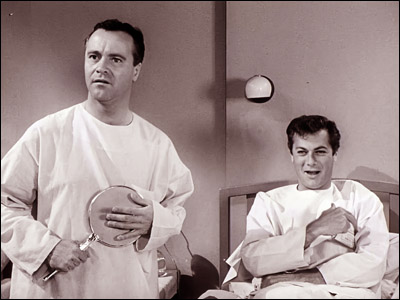
Thereafter, Patterson and Damone played Jerry and Joe for the rest of the pilot and for all episodes thereafter. Unfortunately — or perhaps fortunately — there were no other episodes. No sponsor picked it up nor did NBC. The character of Sugar Kane Kowalczyk — played so memorably in the film by Marilyn Monroe did not appear in the pilot but Tina Louise, later of Gilligan's Island fame, played a similar type of lady named Candy Collins.
And Sweet Sue, played in the movie by Joan Shawlee, did reappear in the sitcom version. She was played by — wait for it — Joan Shawlee.
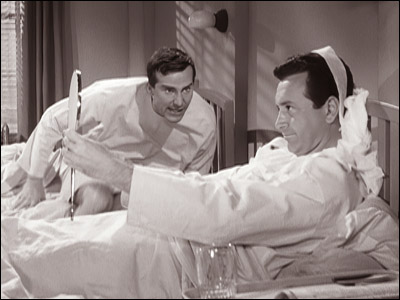
Dick Patterson was another one of those actors who appeared in bit parts in almost TV show of the sixties…and the seventies and the eighties. He was part of the troupe of performers who appeared in Billy Barnes revues in the early sixties so he turned up once on The Dick Van Dyke Show. He played talk show host Stevie Parsons there before Richard Schaal took over the role. Patterson was later a frequent sketch player on The Carol Burnett Show when they needed an extra man. He had performed on Broadway with Burnett in Fade Out, Fade In. Dick Patterson passed away in 1999.
Vic Damone was, of course, a popular singer of popular music. He also turned up on The Dick Van Dyke Show and I remember a fun little "summer replacement" show he did in 1961 and again in 1962 on NBC. It was called The Lively Ones — the same name as a hit song he recorded — and I've never seen a trace of it since it originally aired. Mr. Damone left us in 2018.
So now you're probably wondering: How was the Some Like It Hot sitcom pilot? I'm wondering that too. I've never seen it and didn't even know of its existence until just the other day. Maybe someone reading this knows where there's a copy. I wouldn't get my hopes up for a masterpiece, considering the icy response it seems to have gotten from the network and potential sponsor. But it might be interesting to see…especially the sequence in which Lemmon and Curtis turn into two other actors.
Television has adapted (or tried to adapt) a lot of movies and I wonder if anyone ever thought of that. Somehow, I don't think when they were prepping the TV version of M*A*S*H, anyone said, "Hey, what if we got Donald Sutherland and Elliott Gould to appear and in one scene, Hawkeye and Trapper John were severely injured in a shelling and after extensive plastic surgery, they turned into Alan Alda and Wayne Rogers?"
How to "Do" Comic-Con – Part 4
Part 1 can be read here. Part 2 can be read here. Part 3 can be read here. Which brings us to Part 4…
Shortly after this year's Comic-Con, I read a post online — I'm not sure where — where someone accused Comic-Con of failing to "evolve." And at the same time, the same person was accusing the Con of changing and wishing it was more like it used to be. I didn't quite understand the post so I bookmarked it so I could go back and spend more time with it…and now I can't find it.
As someone who has now been to 55 of these, I am well aware that Comic-Con has changed over the years…and guess what? The comic book industry has changed, too. DC Comics and Marvel are now companies that are largely about the exploitation of their properties in films, on TV, in videogames and various additional forms other than printed-on-paper comic books. There are also dozens of new companies, some with very different business models and hundreds of small publishers or creators who self-publish.
Something else that has changed: The ways in both new comic books and old ones are sold. One reason there aren't more dealers selling old comics there is that many vendors now find it easier and/or more lucrative to sell via online sites like eBay or online auctions. Why lug around crates of old books when you can (often) get a better price without shlepping them great distances, carrying them into the convention center, setting up a booth, carrying the crates back out to a van, driving them home, taking them back inside wherever you store them, etc.?
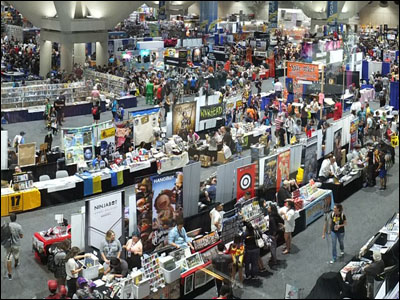
Also, here are two basic rules of conventions: The greater the attendance, the more they charge for exhibitor space. And the more they charge for exhibitor space, the less likely dealers are to bring cheap comics. That's not just Comic-Con. That's all conventions. If you're looking for real inexpensive old comics, a big convention is not the place to find them.
Finally: A core part of Comic-Con has always been the comic book creators. Over the years at these events, I had the honor/privilege/duty (call it what you like) of interviewing people like Jack Kirby, Neal Adams, Will Eisner, Gil Kane, John Romita, Gene Colan, Al Feldstein, Harvey Kurtzman, Joe Sinnott, Will Elder, Al Williamson, John Buscema, Dick Giordano, Joe Kubert, Murphy Anderson, Chuck Cuidera, Irwin Hasen, Sheldon Moldoff, Dick Sprang, Dan DeCarlo, John Broome, Gardner Fox, Julius Schwartz, Russ Heath, Joe Giella, Chase Craig, Roger Armstrong, Jim Mooney, George Gladir, Sid Jacobson, Irv Novick, Ric Estrada, Jack Davis, Frank Kelly Freas, Nick Cardy, Victor Gorelick, Kurt Schaffenberger, Stan Lee, Sam Glanzman, Everett Raymond Kinstler, Vince Sullivan, Dan Barry, Lee Ames, Fred Guardineer, Joe Simon, Jack Kamen, Arnold Drake, Bob Haney, Martin Nodell, Dick Ayers, Paul Norris, Bill Lignante, Denny O'Neil, Dan Spiegle, Frank Springer, Mel Keefer, Tom Gill, Herb Trimpe, Leonard Starr, Stan Goldberg and Allen Bellman.
That's 61 names and I could probably list 61 more.
Comic-Con no longer has people like that around. I can't put together a Golden Age Panel or a Silver Age Panel like we used to do and some critics seem to be blaming the convention for this instead of the passage of time. (In case you didn't realize it, the 61 people in the above list have all passed away. In some recent years like this one, I have been unable to even assemble a panel of folks who worked on comics in the seventies. There are many still with us but they either aren't at the con or don't want to leave their tables, where they're making money, for even an hour.)
There are panels about the newer writers and artists. Those of you who are interested in hearing creators talk about their work should try attending some of them. Some of them are very interesting but they're no longer about the birth of the industry…or when folks in my age bracket first discovered comic books and began collecting.
I just don't understand the "Comic-Con needs to evolve" criticism. It seems to me that it has evolved because the world and the industry have evolved. But then I also don't understand when some of the same complainers insist that "Comic-Con needs to get back to its roots" because that's a wish that it would devolve.
If you would like to influence the direction in which Comic-Con goes, I have two suggestions to make. There are two ways you can influence that. One is by showing up and supporting the kind of programming you would like to see more of. No convention programs for empty seats.
A pet peeve of mine back when I was doing all those panels with the above 61 is that there were attendees who would tell me there should be more such panels…and then when we did them, they didn't show up for them. I told this story here before a couple times about one such no-show…
[He] was upset that so much of the Comic-Con wasn't about comics and he felt, I guess, that I'd concur and would rush off to do something about it…maybe throw Robert Downey Jr out of the hall or something. Instead, I told him about that great panel we did on the Golden Age of Batman with Jerry Robinson, Sheldon Moldoff and Lew Schwartz. If you're interested in the history of comics, it doesn't get any more historical than that. I then said to this fellow who was complaining about the con not being about that kind of thing, "I didn't see you there."
And so help me, he replied, "I couldn't be there. I had to get in line to see the 24 panel with Kiefer Sutherland."
That kind of thing happened a lot more often than you might think. So what I suggest is that you support the kind of programming you want to see by actually attending it when it's offered…and this next point is so important, I'll put it in all caps: TALK IT UP ON SOCIAL MEDIA. That helps, people. It really helps and not just for Comic-Con. If you see a great presentation, write about it on Facebook or Instagram or Tik-Tok or whatever alias Twitter is going by this week. You have some power to influence the programming at conventions. Use it.
That's about all I have to say this time out. There will be at least one other part in this series soon but they all go to my main point, which is that you can't just show up at Comic-Con and have the best possible time. You need to understand the event you're attending and understand what you want to get out of it. Once you do both those things, you can indeed have the best possible time. In that next part, I'll tell you some of the many mistakes I made before I learned what the hell I was doing there.
